
Do you know how to determine if a noun should have an apostrophe? Do you know where to place apostrophes in possessive nouns? Do you know when to use there vs. they're? These are all topics that are tested on the SAT.
The SAT Writing section has questions about possessive nouns and pronouns. In this article, I'll provide you with all the rules and strategies to correctly answer these questions.
Possessives on the SAT
Possessives indicate ownership. Here are some example sentences with the possessives underlined:
Sergio’s kindness is amazing.
The students’ behavior was unacceptable.
Their voices should be heard.

Generally, you can expect about 2-4 questions about possessives on the SAT. The questions on possessives will test your knowledge of possessive nouns and possessive pronouns.
Possessive Nouns
On the SAT, you will be tested on how to correctly form possessive nouns. Thankfully, the basic rules for forming possessive nouns are pretty simple.
If a word is singular or if it’s plural but it doesn’t end in “s,” then you add an apostrophe and then an "s" to the end of the word.
The giraffe’s neck is really long.
The children’s playground has monkey bars.
To create a possessive for a plural word that does end in “s,” just place the apostrophe after the “s.”
I saw a dance troupe perform last night, and I was impressed with the dancers’ skills.

Prayitno/Flickr
On the SAT Writing section, the questions on possessive nouns are about determining whether an apostrophe is needed, and if so, whether the possessive is singular or plural.
Should a Noun Be Possessive?
To determine if a noun should be possessive, take the noun, put an “of” in front of it, and stick it after the noun or phrase that follows it. Here’s an example:
The schools code of conduct is very strict.
Here’s how you change the sentence to determine if “school” should be possessive:
The code of conduct of the school is very strict.
Does that make sense? Yes. The sentence is referring to the code of conduct belonging to the school; therefore, “school” should be possessive. This is the corrected sentence:
The school’s code of conduct is very strict.
Also, plural nouns don’t contain apostrophes. Check out this example:
Incorrect: I downloaded 15 song’s yesterday.
Correct: I downloaded 15 songs yesterday.
Is the sentence describing "yesterday of the song?" No. That doesn't make much sense. The sentence is just using the plural form of the word “song” because there was more than one song downloaded. Because the noun isn’t being used as a possessive, there shouldn’t be an apostrophe.
Should the Possessive Noun Be Plural or Singular?
The other factor you’ll have to consider is whether a possessive should be plural or singular. As mentioned above, that can have an impact on where the apostrophe is placed. For example, “the candidate’s rhetoric” refers to the rhetoric of one candidate, and “the candidates’ rhetoric” refers to the rhetoric of more than one candidate. Use context clues to determine if the possessive should be singular or plural. Example:
Every contestant’s goal was to win the grand prize.
Should the possessive be singular or plural? This sentence can be tricky for some students. Are we referring to the goal of one contestant or many contestants. Some may incorrectly assume that the possessive should be plural. However, “every” implies that we’re talking about the goal of each contestant individually. To remember that “every” implies singular, think of “every” as “every single.”
Check out another example:
All of the contestants’ buzzers weren’t working.
“All” implies more than one; therefore, we should use a plural possessive and the apostrophe should come after the “s.”
SAT Example
The SAT will test you on the issues we just discussed. Use your knowledge of possessive nouns to answer these questions.
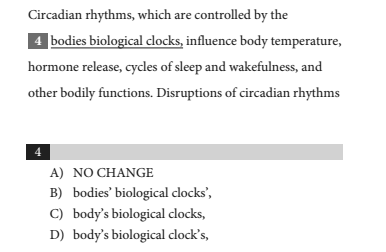
There are two nouns in this sentence, “bodies” and “biological clocks.” Based on the answer choices, we know that we have to determine whether each noun is a plural noun, a singular possessive, or a plural possessive. You should recognize that “biological clocks” is a plural noun; there is no noun or phrase that follows “biological clocks” before the comma, and the sentence is not referring to anything of the biological clocks. Therefore, that noun shouldn’t contain an apostrophe. Immediately, we can get rid of B and D.
Now we have to determine whether “bodies” should be a noun or a possessive. Let’s try the replacement method. Is the sentence stating that circadian rhythms are controlled by the "biological clocks of the body?" Yes. The sentence is indicating possession and “bodies” should be in the possessive form. The correct answer is C. The sentence is referring to the body in general and not multiple bodies, so we use the singular possessive form.
Try one more example:
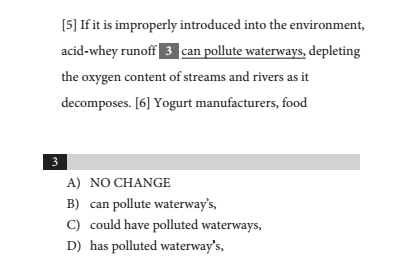
From the answer choices, we know we have to determine whether “waterways” should be a possessive or a plural noun. Again, let's use the replacement method. Is the sentence describing something of the waterways or referring to more than one waterway? It should be a plural noun without an apostrophe because the sentence is stating that acid-whey runoff can pollute waterways. There is nothing indicating possession. Therefore, we can eliminate B and D.
Now the question becomes a verb tense question. Because the sentence begins in the present tense with “is,” the correct answer should also have a verb in the present tense to maintain consistency. The correct answer is A.
Possessive Pronouns
The SAT will also test you on possessive pronouns. Examples of possessive pronouns include “my,” “your,” “its,” “his,” “her,” “our,” and “their.” Most of the SAT questions on possessive pronouns will test you on the third person possessive pronouns “its” and “their.” There are two types of possessive pronoun questions: word choice and pronoun agreement.
Word Choice Homophones
These are the most common type of possessive pronoun questions. Homophones are words that sound the same but have different meanings. Typically, you’ll have to choose whether to use “there,” “they’re,” or “their.” Or you’ll have to choose between “its” and “it’s.” Here is a table showing these common homophones and how they're used.
| there- usually shows location or that something exists | they're- contraction for "they are" | their- plural possessive pronoun |
| its- singular possessive pronoun | it's- contraction for "it is" |
Check out these example sentences that demonstrate how these words are used:
Incorrect: The girls said mean things. There statements were unkind.
Correct: The girls said mean things. Their statements were unkind.
In this sentence, we can determine that the underlined word should be a possessive pronoun by using the replacement technique. The sentence is saying that the statements of them were unkind. The word “there” can be used in multiple ways, but to keeps things simple, just remember that “their” indicates possession and “there” doesn’t.
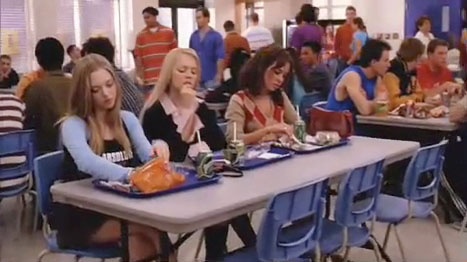
silverkeys/Flickr
Also, keep in mind that the word “they’re” is a contraction for “they are.” You can only use “they’re” if it can be replaced with “they are.”
Incorrect: I love my friends. Their the best.
Correct: I love my friends. They’re the best.
The underlined word is not indicating possession, but it can be replaced with “They are.” “They” is a pronoun that refers to my friends and “are” is the verb in the sentence.
Check out one more example:
Incorrect: The puppy was wagging it’s tail.
Correct: The puppy was wagging its tail.
The word “it’s” is a contraction of “it is.” The word “its” indicates possession. The sentence is referring to the tail of the puppy or the tail of it. To correctly answer these types of questions, use the replacement technique to determine if the underlined word should be a possessive pronoun.
Possessive Pronoun Agreement
There may also be questions dealing with pronoun agreement. The main rule you have to remember is that a pronoun must agree with its antecedent in number. Singular pronouns must refer to singular nouns and plural pronouns must refer to plural nouns. Here are some examples:
Incorrect: Sheila untied their shoes.
Correct: Sheila untied her shoes.
Incorrect: The chairs had dust on its legs.
Correct: The chairs had dust on their legs.
In the first sentence, the pronoun “their” describes the shoes of Sheila. Because Sheila is one person, we need to use the singular pronoun “her.”
In the second sentence, the underlined pronoun refers to the legs of the chairs. Because “chairs” is plural, we should use the plural possessive pronoun “their.”
SAT Examples
Answer these questions related to possessive pronouns.
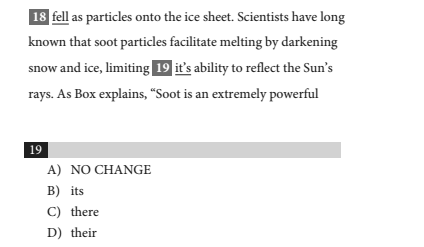
First, let’s determine if the underlined word should be a contraction or a possessive. Does the word mean “it is” or is it a possessive? Let's try the replacement technique. Does this sentence work?
Scientists have long known that soot particles facilitate melting by darkening snow and ice, limiting the ability of snow and ice to reflect the Sun's rays.
Yes. That works. The sentence is referring to the ability of snow and ice to reflect the Sun’s rays; therefore the underlined word is a possessive. So we can get rid of A and C.
Now we have to determine if the possessive pronoun should be singular or plural. What has the ability to reflect the Sun's rays? Snow and ice. That's two things, so the pronoun that takes their place needs to be plural. The correct answer is D.
Try one more possessive pronoun question.
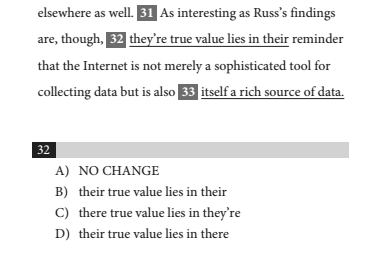
In this question, there are two words in the underlined phrase that could be possessive pronouns. The first is the word “they’re,” which is a contraction for “they are.” Should that word remain the same, be the word “there,” or the possessive pronoun “their?” The sentence implies that the word is referring to the value of his findings, or “their value.” Therefore, we can immediately eliminate A and C.
Next, let’s look at the underlined pronoun “their” after “in.” That word also refers to findings and should be a possessive. Thus, that word should remain the same and the correct answer is B.

Review: Strategies for Possessive Questions
Here are the most important tips to remember to conquer the SAT Writing questions about possessives.
#1: Use the Replacement Technique
Once you see a possessive underlined or in the answer choices, make sure you determine whether the word should be a possessive.
Remember that “Justin’s book” is another way of saying “the book of Justin.” If you saw “Justins book,” you should recognize that there is an error because the phrase is referring to the book of Justin. If a sentence doesn’t work using the replacement technique, then the underlined word is not a possessive.
#2: Singular or Plural?
If you determine that one of the underlined words should be a possessive, then you need to decide whether the possessive should be in the singular or plural form. Use the replacement technique, and if the possessive is "of (singular noun)," then you need a singular possessive. If the possessive is "of (plural noun)," use a plural possessive.
#3: Focus on Apostrophe Rules
For possessive nouns, remember your apostrophe rules. For singular nouns or plural nouns that don’t end in “s,” just add an apostrophe to the word and then an “s.” For plural nouns that end in “s,” just and an apostrophe after the “s.”
#4: Know Your Contractions
On possessive questions, you may have to choose between “it’s” and “its” or “their” and “they’re.” Remember that “it’s” is a contraction for “it is” and “they’re” is a contraction for “they are.” If you select “it’s,” the sentence would have to make sense and be grammatically correct if you substituted “it’s” for “it is.” Similarly, if you selected “they’re,” the sentence would have to work if you substituted “they’re” for “they are.”
What's Next?
As you continue your SAT Writing studying, make sure you know the 12 most important grammar rules. Also, pay special attention to punctuation and transitions.
Finally, if you're familiar with the old SAT, find out how SAT Writing has changed.












